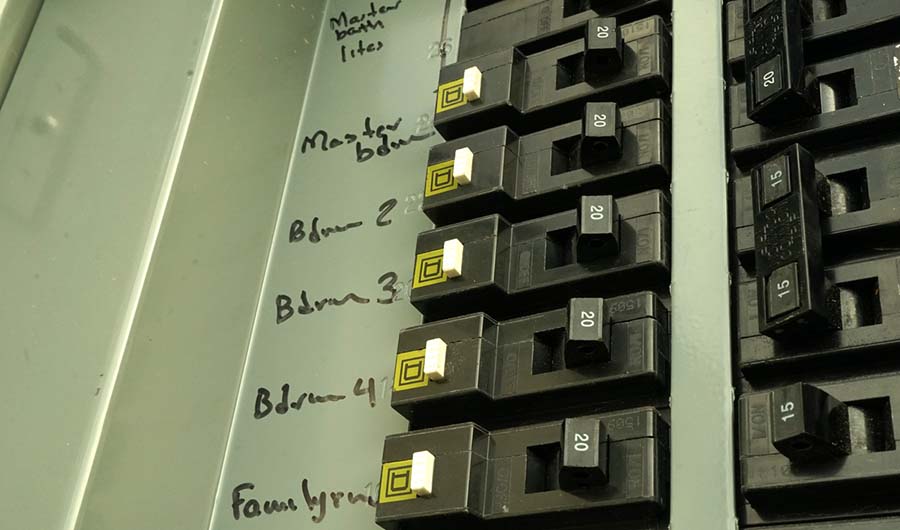
Most households have a plethora of electrical appliances, some of which are motorized and require a circuit of their own while others do not. It is relatively common for new homeowners or those who have limited knowledge about the nitty-gritty of electrical circuits to have concerns about how many outlets or gadgets can safely go into a particular circuit.
One of the most common points of confusion is the 20-amp circuit found in almost every residential or commercial building. If you want to know how many lights you can run on a 20-amp circuit, you have come to the right place.
You can run a maximum of 40 lights of 50 watts each on a 20-amp 120-volt circuit. In the case of a 20-amp 240-volt circuit, generally only found in commercial buildings, you can run up to 75 lights of 50 watts each.
Read on to find out all that you need to know about 20-amp circuits so that you can get the most out of them while avoiding any potential accident.
What Can You Run Off a 20-Amp Circuit?
Following the 80% percent load rule, you should only run mid-range appliances on a 20-amp breaker to ensure that the maximum current draw does not exceed the 15-amp threshold.
You can safely run gadgets such as toasters, coffee machines, electric griddles, blenders, hand mixers, and other similar kitchen appliances on a 20-amp circuit.
Power tools used in residential garages such as air compressors, table saws, and other such equipment call for a dedicated 20-amp circuit. 20-amp circuits can also accommodate a lighting system depending, of course, on the wattage of the lights.
Can You Run Lights on a 20-Amp Circuit?
You can run lights on a 20-amp circuit as long as it is not a dedicated 20-amp circuit installed specifically to run one appliance. Installing light fixtures on a dedicated 20-amp circuit violates the National Electrical Code. Any other 20-amp circuit can easily accommodate lights, provided that the total current draw is well within its load capacity.
How Many Lights Can You Run off a 20-Amp Breaker?

You can safely run up to 40 50-watt lights on a 20-amp breaker of 120 volts. A 20-amp breaker of 240 volts, on the other hand, can handle a maximum of 75 lights of 50 watts each.
Therefore, the former is better suited for residential lighting systems, while the latter is more suitable for lighting systems in commercial buildings.
How Many Outlets Can I Install on a 20-Amp Circuit?
If you plan on installing receptacles on your 20-amp circuit, it’s judicious to install no more than 10 of them.
One outlet has a power draw of up to 180 watts. Hence, a 20-amp 120-volt circuit can accommodate a maximum of 10 such outlets, with a sufficiently large margin for safety.
What is Circuit Load Capacity?
Circuit load capacity essentially refers to the wattage that can be safely drawn out of a circuit at one time without overloading the system. In other words, load capacity is the total number of electrical channels that can be safely handled by one circuit at a given point in time.
If the electrical demand of an appliance exceeds the circuit load capacity, it could result in the tripping of the circuit breaker or the blowing up of its fuse. It could also cause damage to the appliance. Such events may even lead to an electrical fire. It is, therefore, crucial to determine the load capacity of a circuit before running one or more appliances or installing outlets on it.
Calculating Circuit Capacity
The calculation of circuit load capacity involves a simple relationship principle called Ohm’s Law which can help ascertain the maximum wattage that any given circuit can handle. According to this law, amperage x volts = watts. Applying this principle, for instance, to a regular residential 20-amp 120-volt circuit, we can very easily determine its maximum load capacity.
Similarly, when dealing with a commercial 20-amp 240-volt circuit, we can determine its load capacity by applying the same principle.
20 amps x 240 volts = 4800 watts
However, it’s vital to bear in mind that the breaker in a circuit can safely take only up to 80% of its maximum load capacity. So, when installing receptacles or running appliances on a circuit, it is of seminal importance that you leave a small margin solely for safety purposes.
What is a Dedicated Circuit?
You can install a dedicated appliance circuit with its very own circuit breaker. It is meant for running a singular appliance with a high wattage demand. A dedicated circuit ensures that the gadget in question can draw sufficient electrical current for its functioning without overloading the system and causing the fuse to blow up or the breaker to trip.
Dedicated circuits can be of anywhere between 20-50 amperage, depending on their specific use case. The National Electrical Code mandates them for heavy-duty electrical appliances.
Appliances That Require a Dedicated Circuit
Heavy-duty appliances that require a dedicated circuit include air conditioners, electric water heaters, dishwashers, microwaves, refrigerators, washing machines, furnaces, electric ovens, trash compactors, garbage disposal units, and myriad other everyday household gadgets.
Dedicated 20-Amp Circuit
Dedicated 20-amp circuits generally run mid-range appliances such as home entertainment systems and small kitchen appliances. If you are unsure as to whether yours is a dedicated 20-amp circuit, look for a slot that resembles a sideways letter ‘T.’
You could also look at your breaker panel and look for a breaker handle bearing the number 20 on it. These are clear indicators of a dedicated 20-amp circuit.
Key Takeaways
To make good use of the electric supply in your residential or commercial establishment, learning the relevant best practices stated in your local electrical code is essential.







